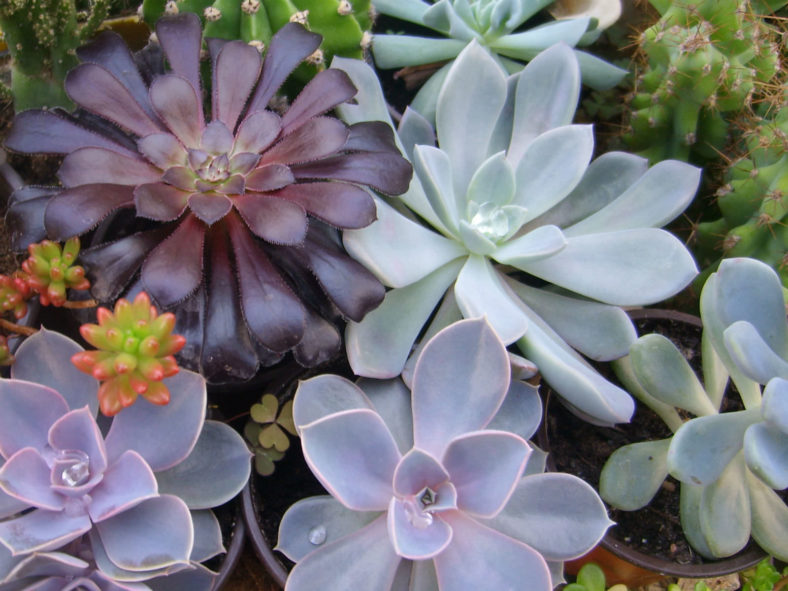In botany, succulent plants, also known as succulents or sometimes fat plants, are plants with some parts that are more than normally thickened and fleshy, usually to retain water in arid climates or soil conditions. The word "succulent" comes from the Latin word "sucus," meaning "juice or sap." Succulent plants may store water in various structures, such as leaves and stems. Some definitions also include roots so that geophytes that survive unfavorable periods by dying back to underground storage organs may be considered succulents.
Succulents are often grown as ornamental plants because of their striking and unusual appearance. About 60 different plant families contain succulents. Most plants are succulents in some families, such as Cactaceae, Aizoaceae, and Crassulaceae. The habitats of these water-preserving plants are often in areas with high temperatures and low rainfall. Succulents can thrive on limited water sources, such as mist and dew, making them equipped to survive in an ecosystem with scarce water sources.
Definition
A general definition of succulents is drought-resistant plants in which the leaves, stem, or roots have become more than usually fleshy by developing water-storing tissue. Other sources exclude roots as in the definition "a plant with thick, fleshy and swollen stems and/or leaves, adapted to dry environments." This difference affects the relationship between succulents and geophytes, plants that survive unfavorable seasons as a resting bud on an underground organ. These underground organs, such as bulbs, corms, and tubers, are often fleshy with water-storing tissues. Thus if roots are included in the definition, many geophytes would be classed as succulents.
Plants adapted to living in dry environments, such as succulents, are termed xerophytes. However, not all xerophytes are succulents since there are other ways of adapting to a water shortage, e.g., by developing small leaves that may roll up or have leathery rather than succulent leaves. Nor are all succulents xerophytes since plants like Crassula helmsii are both succulent and aquatic.

Those who grow succulents as a hobby use the term in a different way than botanists. In horticultural use, the term succulent regularly excludes cacti, but in botanical terminology, cacti are succulents. Horticulturists may also exclude other groups of plants, e.g., Bromeliads. A practical but unscientific horticultural definition is "a succulent plant is any desert plant that a succulent plant collector wishes to grow." Such plants less often include geophytes (in which the swollen storage organ is wholly underground) but do include plants with a caudex that is a swollen above-ground organ at soil level, formed from a stem, a root, or both.
A further difficulty is that plants are not either succulent or non-succulent. There is a continuous sequence in many genera and families, from plants with thin leaves and normal stems to those with very clearly thickened and fleshy leaves or stems. So deciding what a succulent is is often arbitrary. Different sources may classify the same plant differently.
Appearance
Water storage often gives succulent plants a more swollen or fleshy appearance than other plants, a characteristic known as succulence. In addition to succulence, succulent plants variously have other water-saving features. These may include:
- Crassulacean acid metabolism (CAM) to minimize water loss
- Absent, reduced, or cylindrical-to-spherical leaves
- Reduction in the number of stomata
- Stems as the main site of photosynthesis, rather than leaves
- Compact, reduced, cushion-like, columnar, or spherical growth form
- Ribs that enable rapid increases in plant volume and decreasing surface area exposed to the sun
- A waxy, hairy, or spiny outer surface to create a humid micro-habitat around the plant, which reduces air movement near
- The surface of the plant thereby reduces water loss and creates shade
- Roots are very near the surface of the soil, so they can take up moisture from tiny showers or even from heavy dew
- Ability to remain plump and full of water even with high internal temperatures, e.g., 126 °F (52 °C )
- Very impervious outer cuticle (skin)
- Mucilaginous substances, which retain water abundantly.
Habitat
Many succulents come from dry areas such as steppes, semi-deserts, and deserts. High temperatures and low precipitation force plants to collect and store water to survive long dry periods. Some species of cacti can survive for months without rainfall. Succulents may occasionally occur as epiphytes and air plants, as they have limited or no contact with the ground and depend on their ability to store water and gain nutrients by other means. This niche is seen in Tillandsia. Succulents also occur as inhabitants of sea coasts and dry lakes exposed to high levels of dissolved minerals that are deadly to many other plant species.
Source: wikipedia.org
Links
- Succupedia: Browse succulents by Scientific Name, Common Name, Genus, Family, USDA Hardiness Zone, Origin, or cacti by Genus